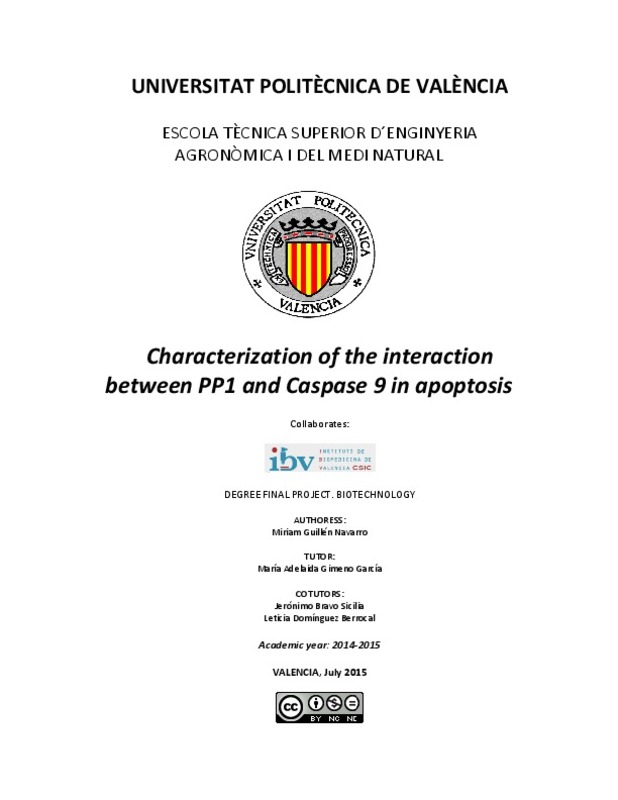|
Resumen:
|
[ES] La proteína fosfatasa 1 (PP1) pertenece a la familia PPP de fosfatasas, desfosforila cientos de dianas biológicas clave y su apoenzima (apo-PP1) está asociada con cerca de 200 proteínas regulatorias para formar ...[+]
[ES] La proteína fosfatasa 1 (PP1) pertenece a la familia PPP de fosfatasas, desfosforila cientos de dianas biológicas clave y su apoenzima (apo-PP1) está asociada con cerca de 200 proteínas regulatorias para formar holoenzimas específicas. Es una de las enzimas más abundantes de la célula y está involucrada en la regulación de procesos celulares como la apoptosis. La apoptosis es un fenómeno de muerte celular programada involucrado en muchas funciones fisiológicas, entre las que se encuentra proteger contra el cáncer. Caspasa 9 es la última de las caspasas iniciadoras de la ruta de apoptosis dependiente de caspasas. Caspasa-9 activa es capaz de procesar y activar caspasa-3,-6 y -7, que amplifican la señal de apoptosis. Un estudio reciente (Dessauge et al. 2006) ha demostrado que PP1 interacciona y desfosforila a caspasa-9 directamente, activando su acción proteolítica de manera independiente a las rutas descritas hasta ahora. Este proyecto tratará de caracterizar la interacción entre PP1 y caspasa 9 y elucidar los mecanismos moleculares que actúan en la regulación de la apoptosis a este nivel. Para ello, se clonarán los constructos necesarios de caspasa 9, se optimizará la purificación de PP1 y se realizarán ensayos biofísicos como Thermofluor e ITC entre ambas proteínas purificadas.
[-]
[EN] Apoptosis is a highly regulated form of programmed cell death that eliminates individual cells
in a controlled way, playing a key role in the maintenance of tissue homeostasis. Apoptotic cell death
is deregulated ...[+]
[EN] Apoptosis is a highly regulated form of programmed cell death that eliminates individual cells
in a controlled way, playing a key role in the maintenance of tissue homeostasis. Apoptotic cell death
is deregulated in some conditions, such as cancer, having devastating effects in the organism. The
main executors in this process are a family of cysteine aspartatyl-specific proteases, caspases, which
induce controlled cell death by cleaving target cellular proteins in specific aspartic residues. Caspase
9 is the last initiator caspase in the caspase-dependent apoptotic pathway and it is able to process
and activate caspases 3,6 and 7, amplifying the apoptotic signal. From this point on, the execution
of cell death is irreversible. Due to its function, caspase 9 represents a molecular target in cancer
therapy strategies. Dessauge et al (2006) have demonstrated that PP1α directly dephosphorylates
caspase 9, activating it, thus promoting its protease activity and the irreversible cell entry in
apoptosis. PP1 is an ubiquitous serine/threonine phosphatase that regulates different important
cellular processes. It dephosphorylates hundreds of crucial biological targets and its apoenzyme is
associated with more than 200 regulatory proteins to form specific holoenzymes. The
characterization of the PP1-caspase 9 interaction would provide useful information about the
molecular mechanism of caspase 9 activation in the context of apoptosis. For this purpose, the
human proteins have been overexpressed as fusion proteins in BL21 or BL21 codon plus E.coli
strains. Several constructs of PP1 and caspase 9 were purified by using both affinity chromatography
and size-exclusion chromatography to perform further interaction assays. Binding characterization
using pull-down assays and biophysical techniques such as Biolayer Interferometry (BLI) and
Isothermal Titration Calorimetry (ITC) verified a weak interaction between PP1 and caspase 9 full
length, but not with CARD or ΔCARD domains. This suggests that the strength of the interaction
depends on several binding sites and it may occur before caspase 9 in vivo processing. Further
strategies using caspase 9 phosphomimetic mutants designed in this work will provide more
information about the residues involved in the affinity of the interaction.
[-]
|




![PDF file [Pdf]](/themes/UPV/images/pdf.png)



